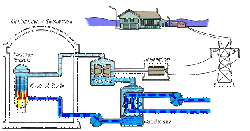Nuclear Energy
Nuclear Power Plants
Nuclear power plants convert the thermal energy released from the fission of the nucleus of an atom into electricity.
| The self-sustaining chain reaction of nuclear fission can be controlled using control rods and a water bath as a modulator that slows and absorbs some neutrons; this controls the rate of more fissions. | A cooling system removes heat from the reactor core and transports it to another area of the plant, where the hot coolant can be used to produce electricity. | The emitted water is either sent into cooling towers where it released as condensed water droplets (like a cloud) or is discharged into, lakes, rivers, or oceans. |
Nuclear power plants that use heat from nuclear fission reactions rely on one of two reactor types.



